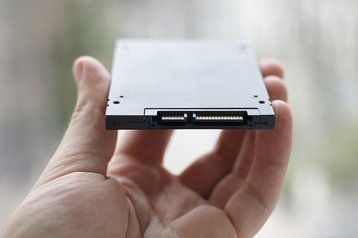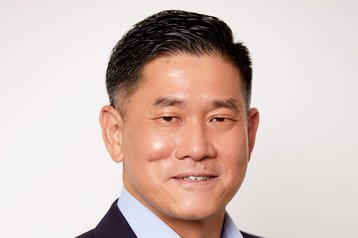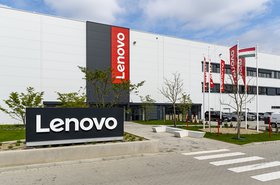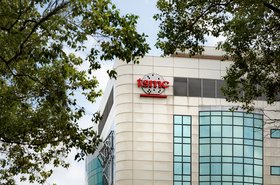For years now, solid-state storage makers have been telling us that hard disk drives (HDDs) have a limited life ahead of them, as their performance is eclipsed by flash memory.
Against that, hard drive makers keep increasing their capacity and delivering lower costs per terabyte of storage, which have kept HDDs in use for the majority of storage.
“In the data center and the enterprise environment, right now, about 90 percent of all data sits on disk drives,” says B S Teh, chief commercial officer at Seagate. “There's always talk about technology that will take over disk drives, but I think with innovation, it's always proven itself to be the mass capacity storage of choice.”
HAMR time
He is talking to DCD because he has an announcement to make: “This is not just any technology announcement," Teh says. "I would categorize this as one of the most impactful and significant technology shifts, that the [hard drive] industry has seen, in its entire history.”
That’s a big claim, but he’s talking about heat-assisted magnetic recording (HAMR), a technology which is set to double the capacity of HDDs, by yet again increasing the density of the data they can hold.
“We are reducing the size of the magnetic particles, and we're also squeezing them a lot tighter together,” he says. “The result is a dramatic increase in areal density,”
The basics of the technique are easy to explain. HDDs work by writing and rewriting the magnetic polarity of tiny grains in the disk platters as they spin. Density increases as the particles get smaller, but so does the risk that the grains will lose their magnetism, or be remagnetized by nearby reads and writes.
“If you put two magnetic particles too closely together, it becomes unstable,” says Teh. “That's just physics.”
It’s possible to magnetize smaller grains, in a platinum alloy medium, but there’s a problem. It doesn’t work at room temperature. HAMR gets around that by quickly heating up a tiny dot on the medium, so it can be magnetized, and then letting it cool and stabilize.
“To raise the temperature so you can write on it,” he explains, “we use a laser beam that will zap the magnetic bit, and heat it up so that we can then read and write.”
Stagnant HDDs
It’s a significant moment because, frankly, HDDs have been in the doldrums.
Shipments of HDDs have been dropping for the last two years, and Seagate’s revenue fell by 50 percent. To be honest, some may be wondering whether we should care about his new change,
Teh thinks HDDs have been hit by a general slowdown in the economy, supply chain problems, and also a period during the Covid pandemic when customers overbought: “The fact is that the last few years were a very tough time for the industry.”
Against that backdrop, HAMR, which Seagate is launching under the name Mozaic 3, is not actually that new and surprising. Seagate first planned to deliver it way back in 2009, and that date got pushed to 2015, 2019, and 2021. DCD has been hearing about it for years.
Teh explains: “I think there are two challenges. Number one is productizing the technology. There’s been more than 20 years of R&D and hundreds of millions of dollars in investment, starting from the year 2000.”
Secondly, he says, there is the "continuous innovation of the existing technology." Thanks to the addition of helium, and other tweaks, “the older technology continued to have legs, so we were able to extend the lifecycle of the technology and push out the platform transition.”
Alongside the development of HAMR, there have been other ideas including a stopgap called “shingled” recording and microwave-assisted magnetic recording (MAMR) which he sees as “bridging” technologies: “MAMR is not a technology that will allow you to go from A to B, but it, may take you from A to A+," Teh argues.
Boost in demand
Now is the time to announce the change because AI will demand more storage, especially as it moves from a focus on training to inference (application): “Training is very GPU and compute-centric, but when you move to inference, where you're actually using the models, your compute requirement drops dramatically. You don't need those expensive GPUs to run every query, and it becomes more and more data-centric, because you're generating and creating more data as you use the application.”
Between 2022 and 2026, he believes the global “datasphere” (the world’s total storage) will more than double. HAMR will enable that, he says: “With HAMR technology, we're able to double the growth that we've seen in the last 10 years.”
In recent times, faced with slack demand, densities have gone up by less than 10 percent a year, Teh explains: “Now, we're talking about doubling that to over 20 percent CAGR of the areal density,” he beams. “To put it another way, in about four years, you can see a doubling of the capacity in areal density and consequently in the size of the disk drive that you see.”
As well as greater capacities HAMR will also address demands for space and power, he says. HDDs will hold more storage in the same size units, which have essentially the same cost and environmental footprint.
“For a given floor space, you can increase the amount of capacity that you can deploy in a data center,” he says, “If you take out all the 16 Tbyte drives and replace them with 30 Tbyte units, you immediately save 40 percent in Watts per terabyte.”
He thinks that the new units will have the same service life, lasting around 10 years: “We've got every reason to believe that it'll be just as reliable or even more reliable than previous generations.”
Adding tiny lasers to the read/write head will add an increment to the price, he admits. While Seagate has produced the new heads and media in-house, along with the controller chips, the laser is new: “We never used a laser before, and went with an outside partner to develop that.”
The partner produces lasers that are fast and focused enough to operate on tiny grains moving at speed, and small enough to mount on the read/write head. In time Seagate will make its own lasers: “We've felt the need to develop it in-house as well, to complement the external partner that we have.”
Price and space
As to the price, he says: “The overall cost per terabyte is still lower than the previous generations, I will say that there is no premium - in fact, you get TCO benefits by moving into the new platform versus the older platform on a cost per Tbyte basis.”
The first qualification units are already shipping and Teh hopes to get major customers buying it in quantity by the end of Q1 2024. The first customers will be large cloud service providers, but eventually lower-end drives will have HAMR.
“We're coming up with variations of the drive,” he says. “Today, if you were to buy a 12TB hard disk, you probably need one with at least six platters inside. In the future we're coming out with variants drive with fewer platters, so you could conceivably get 12TB with five disks or less, which actually makes it a lower cost product.”
Other vendors will follow with HAMR, he says: “We certainly hope they will, because it's just going to be beneficial for the industry.”
For now, though, Teh says Seagate is "the only company that has this technology commercially available."
He says: "We're the first to be able to announce and ship a three-terabyte hard disk product. And the good news is that we've got follow-on products to grow to four terabytes per disk and five terabyte products as well.
“This is not just a one-trick pony. It's a new platform, an inflection point that will take us to bigger and better places. “
Eye on the competition
Solid-state drives continue to expand - and their presence clearly has had a bigger role in the declining market for HDDs than Teh likes to admit.
“It's our view is that all the devices that are in mass production today have a role to play,” he says, adding in tape to the array of options. “It's all complimentary. We don't see a scenario where one technology takes over the other completely.”
HAMR will let HDDs keep their price advantage he says: “Solid state is at least five times more expensive. If you're a cloud service provider, and you are selling bits gigabytes for dollars, you can't pay five times more per gigabyte.”
Considering the possibility that all HDDs would be replaced by solid-state drives, he says: “They're going to have to invest over $200 billion in capex just to have enough capacity - and consider the amount of time to actually get the fabs up. No, the industry doesn't have the money to invest $200 billion.
“Over time, yes, solid state will have a higher percentage of the share overall. But no, it's not going to replace hard drives for a long, long time.”
This feature first appeared in issue 52 of DCD Magazine. Click here to read the magazine in full.





